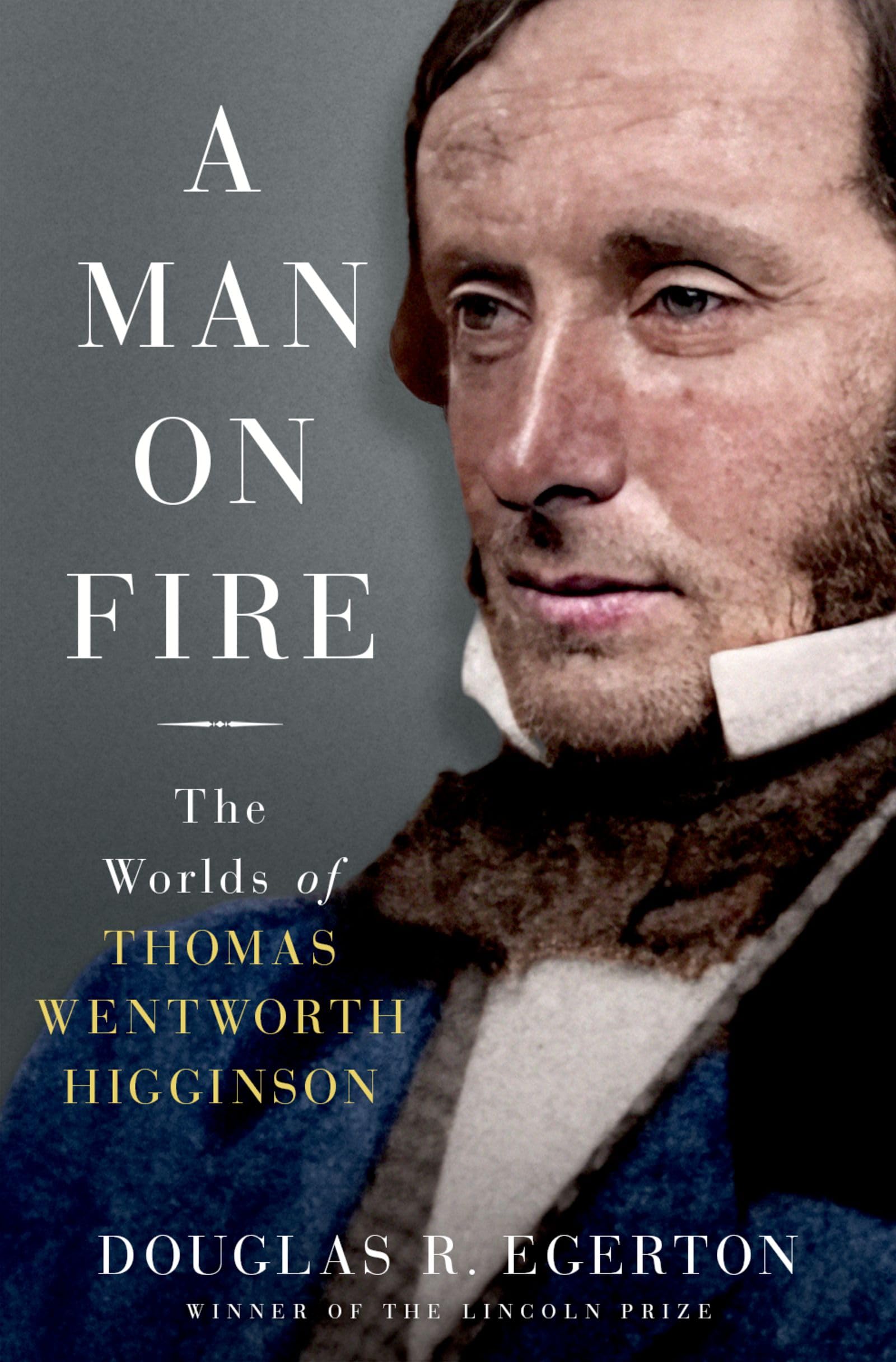Book Review: A Man on Fire: The Worlds of Thomas Wentworth Higginson
A Man on Fire: The Worlds of Thomas Wentworth Higginson. By Douglas R. Egerton. New York: Oxford University Press, 2024. Hardcover, 352 pp., $35.00.
Reviewed by Tim Talbott
The last decade has offered readers a wealth of abolitionist studies. From those providing broad-range histories to those focusing on narrow topics, it seems that no stone is going unturned to help us better understand the many nuances of this rather small, but extremely vocal and politically influential, yet sometimes divided, group of progressives.
Among the recent abolitionist studies, biographies have perhaps assumed the lead. Major new life histories on, and about aspects of, individuals like Frederick Douglass, Charles Sumner, Thaddeus Stevens, Wendell Phillips, William Still, James Montgomery, Harriet Tubman, John Brown, and the Beecher family, among others, are informing readers with new discoveries and offering fresh thought-provoking interpretations. Historian Douglas R. Egerton wades into this deepening abolitionist biography pool with A Man on Fire: The Worlds of Thomas Wentworth Higginson.
Unlike many of Higginson’s abolitionist contemporaries, he has not received a large amount of previous scholarship. As Edgerton argues in the book’s introduction: “Higginson’s lifelong refusal to tether himself to a single issue has today kept him from fame by association with one. Scholars, whether of antislavery or literary or gender studies, tend to tell only part of Higginson’s story. (7) Egerton avoids that trap by offering a holistic look at, as the subtitle states, The Worlds of Thomas Wentworth Higginson.
As mentioned above, Higginson was well-rounded in his interests and activism. Beginning his adult life as a minister, and often requiring he be allowed to speak his mind from the pulpit in his clergy contracts, he tackled issues that he determined were social ills and that prevented the United States from reaching its full potential. Utilizing his talents and invaluable Harvard education allowed Higginson to supplement his often meager minister’s pay by lecturing, writing, and editing on a wide spectrum of topics including abolitionism, temperance, education, women’s rights, and literature.
Organized into 11 chapters that divide Higginson’s life (1823-1911) up into varying segments, A Man on Fire uses a wealth of primary and secondary sources to tell his life’s story. Higginson was an avid writer. He kept a diary and wrote diligently both private letters to family and friends, as well as articles for publication in periodicals like Atlantic Monthly and in book form. Fortunately, much of his writing has survived. It provides amazing insights into his personality, passions, and perspectives.
Of particular interest to students of the Civil War Era are chapters three through eight, which cover 1849 to 1865. As the sectional storm in the United States brewed over slavery, its potential expansion into the western territories, and its laws demanding the rendition of self-emancipated individuals, Higginson became not only a mouthpiece for abolitionism, but put himself in danger’s way with his commitment to ending slavery. He was among those who physically attempted to free the captured Anthony Burns in Boston in 1854. Higginson received a gash on his chin from a soldier’s sword for his efforts.
He not only donated money to prevent Kansas from becoming a slave state, but ventured west from his comfortable Massachusetts home to provide aid and encouragement to those fighting Border Ruffians on the front lines. Higginson also gave financial aid and supported John Brown’s militant abolitionist efforts, becoming one of Brown’s celebrated (or vilified, depending on one’s perspective) Secret Six. It was Higginson alone, who when identified as being a supporter, did not seek to hide or deny his role with Brown.
Higginson’s commitment to seeing the end of slavery is perhaps best demonstrated in his military roles during the Civil War. First serving as a captain in the 51st Massachusetts Infantry, and then more famously as colonel of the 1st South Carolina Colored Infantry, “the first federally approved African American regiment,” that later became the 33rd United States Colored Infantry, Higginson gave two years of his life to the Union. (176) Higginson recounted many of his experiences in his 1870 book Army Life in a Black Regiment, which remains popular and in print today.
Although Egerton spends a good deal of the book discussing Higginson’s more visible public life, he also shares important aspects of this Renaissance man’s private existence. In doing so, we often get a more complete idea of Higginson’s true humanity. For instance, Higginson served as an advisor to recluse poet Emily Dickinson, who he found intellectually stimulating; he maintained a close relationship with his mother until her death in 1864; and his first marriage, to Mary Channing, proved challenging due to her many health issues, yet he remained loyal and true. After Mary’s death in 1877, Higginson remarried in 1879 to Mary Thatcher, a union that finally blessed him with children he adored. Until he died in 1911, Higginson continued to write in many different formats and fight for causes he believed in, deftly balancing his public and private worlds all while advocating for positive change.
A Man on Fire: The Worlds of Thomas Wentworth Higginson gives readers the most complete biography yet available about this fascinating individual. Life stories like this one not only inform us about the era in which the subject lived, they are also relevant and can inspire us with what one can accomplish with action and commitment in our own time.


Thomas Wentworth Higginson: proof that one man CAN make a difference.
I can’t resist mentioning there’s also my new and first ever biography of George Boutwell, Radical Republican ally of Lincoln, Grant, Thaddeus Stevens, Charles Sumner, and others; BOUTWELL: Radical Republican and Champion of Democracy (WW Norton), recently reviewed by ECW. Interestingly, Higginson and Boutwell were allies in protesting US annexation of the Philippines following the Spanish American war; Boutwell was president of the anti-imperialist league leading that opposition, which included such figures as Mark Twain, Andrew Carnegie, Jane Addams, and WEB DuBose.